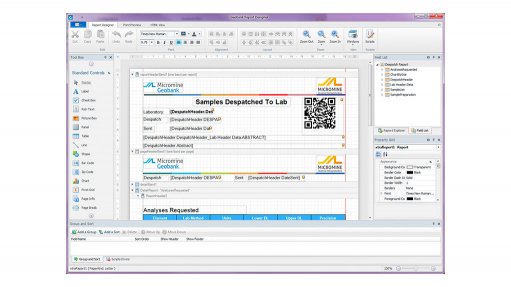
DATA COMPARISON The Sample Tracker module in the Geobank Mobile data management software solution enables users to perform full reconciliation of laboratory dispatch and received samples
A ustralia-based mining software solu- tions and services provider MICROMINE has registered a 20% to 30% demand increase for its flexible and secure Geobank and Geobank Mobile mining data-management solutions software.
MICROMINE Africa customer services manager Craig Peek tells Mining Weekly that significant demand initially came from West Africa. However, East Africa, and particularly Tanzania, has evolved into a strong market for MICROMINE, as the company supplied two of the mining data-management software solutions to the Tanzanian mining industry earlier this year.
Peek says the market includes, but is not limited to, Ethiopia, Rwanda and the Democratic Republic of Congo.
The Geobank and Geobank Mobile solutions are also widely used by coal majors in South Africa, he adds, noting that an updated version of the Geobank Mobile software was released this month.
Geobank Mobile is a field-logging solution that enables mining companies to confidently capture and process geological field data. The solution ensures accurate data capture through real-time validation and rich data input controls that minimise errors at the point of entry.
“From a mining perspective, Africa remains a good location in which to invest,” Peek notes, pointing out that demand for the company’s services can be attributed to the increased drive to improve sustainability of operations, as well as accelerate and ensure validated and accurate data management and analysis.
Peek emphasises that it has become vital for mining companies and exploration houses to access and analyse validated and consistent data, as well as store and access this data in one centralised location.
Geobank and Geobank Mobile provide a data digitisation, securing and validation process, enabling investors and share- holders to easily and quickly access the analysed data to peruse ore grades, resource estimations and additional geological information of exploration projects.
Further, Peek says accessing information can be accelerated from two days to 20 minutes.
“As inconsistent data can negatively impact on projects from the exploration phase, a key aim of MICROMINE is to promote data integrity from the start, which means, once the data is loaded onto Geobank, it is analysed and validated to ensure 100% integrity and reduces human error.”
He adds that the software provides geologists with the means to upload their geological data and preset the lithology, eliminating any errors.
As mine exploration sites are often remotely situated and mining companies require daily, weekly and monthly analysis reports, Peek points out that MICROMINE can set Geobank to run analysis reports automatically and to the desired schedule.
“As mining exploration projects cannot generate a turnover or profit, cost effective, timeous and efficient exploration data collection and analysis are necessary,” Peek stresses, noting that capital and project delays could create significant challenges for mining projects.
He reiterates his belief that significant decisions regarding mining projects and exploration progress are based on data initially collected.
“In light of this, it is preferable for mining companies to start a project with data in a format that can be used to quantify and model the resources before capital is used on extensive drilling,” Peek says.
Advanced Reporting from Geobank He highlights that the Geobank advanced reporting module – which includes charting, data binding, master-detail reports, sub- reports and a fully featured graphical end-user chart designer – has received significant interest.
“The module has been designed to ensure that real-time reporting requirements are achieved through the ability to configure, store and run complex reports. “This enables clients to analyse data from any aspect, including rock volumes and borehole loggings, while clients in the coal mining sector often apply the module to view and analyse composite coal wash tables and ash analysis.”
The advanced reporting module includes a customised reporting summary, which can incorporate mining production information, such as the number of stockpiles processed or production rates, for analysis.
Peek adds that the reports are also widely used in the copper, gold, zinc and nickel sectors.
Other popular features include the core depth adjustment tool for core sampling and the Sample Tracker, which enables companies to store and manage data that pertains to the collection, preparation and analysis of samples.
Peek reiterates that users can customise procedures, perform full reconciliation of dispatch and received samples, and ensure that suspect data is rejected early using the system’s data analysis comparison.
Meanwhile, the professional module enables users and company geologists to manage tenement, drillhole and other exploration data of a project, thereby saving time and improving data quality by adjusting seam logs onto geophysical logs quickly and accurately.
Technology Embracement
Having noted the increase for database and analysis technology in South Africa, Peek believes that the country will “head up the forefront for the rest of the African continent”.
“Mine data remains a core asset, with mines and geologists needing to provide efficient analytical services and geologies, particularly in terms of resource modelling. Therefore, this digital embracement will enhance exploration phases and production efficiencies for the mining industry,” he concludes.